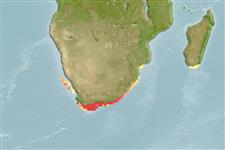>
Centrarchiformes (Basses) >
Latridae (Trumpeters)
Etymology: Chirodactylus: Greek, cheir = hand + Greek, daktylos = finger (Ref. 45335); for the long, unbranched lower pectoral fin rays (Ref. 120445).
More on author: Günther.
Environment: milieu / climate zone / depth range / distribution range
Ecologie
marien demersaal; diepte 0 - 150 m (Ref. 9492). Subtropical; 23°S - 36°S
Southeast Atlantic: Walvis Bay, Namibia to possibly Natal, South Africa. Natal records are likely to be Chirodactylus jessicalorum.
Grootte / Gewicht / Leeftijd
Maturity: Lm ? range ? - ? cm
Max length : 180 cm TL mannelijk / geslacht onbekend; (Ref. 9492); common length : 80.0 cm TL mannelijk / geslacht onbekend; (Ref. 9492)
Korte beschrijving
Determinatiesleutels | Morfologie | Morfometrie
Dorsale stekels (totaal) : 17 - 18; Dorsale zachte stralen (totaal) : 22 - 24; Anale stekels: 3; Anale zachte stralen: 8.
The largest species of the family (Ref. 5319). Primarily an offshore species that prefers rocky or muddy banks. Feeds during the day on small, bottom-dwelling invertebrates. Occasionally also on squid and small fish. Also caught by artisanal and game fisheries (Ref. 9492).
Levenscyclus en paargedrag
Maturiteit | Voortplanting | Paaien | Eieren | Fecunditeit | Larven
Smith, M.M., 1986. Cheilodactylidae. p. 667-668. In M.M. Smith and P.C. Heemstra (eds.) Smiths' sea fishes. Springer-Verlag, Berlin. (Ref. 5319)
Status op de Rode Lijst van het IUCN (Ref. 130435: Version 2024-1)
Gevaar voor de mens
Harmless
Gebruik door de mens
Visserij: van minder commercieel belang; sportvis: ja
Tools
Speciale rapporten
Download XML
Internetbronnen
Estimates based on models
Preferred temperature (Ref.
123201): 15.4 - 23.9, mean 18.1 °C (based on 40 cells).
Fylogenetische diversiteitsindex (Ref.
82804): PD
50 = 0.6250 [Uniqueness, from 0.5 = low to 2.0 = high].
Bayesian length-weight: a=0.01820 (0.00741 - 0.04467), b=2.99 (2.77 - 3.21), in cm total length, based on LWR estimates for this (Sub)family-body shape (Ref.
93245).
Trofisch niveau (Ref.
69278): 3.3 ±0.3 se; based on diet studies.
Weerstandsvermogen (Ref.
120179): Zeer laag, minimale populatieverdubbelingstijd meer dan 14 jaar (Preliminary K or Fecundity.).
Fishing Vulnerability (Ref.
59153): Very high vulnerability (90 of 100).
